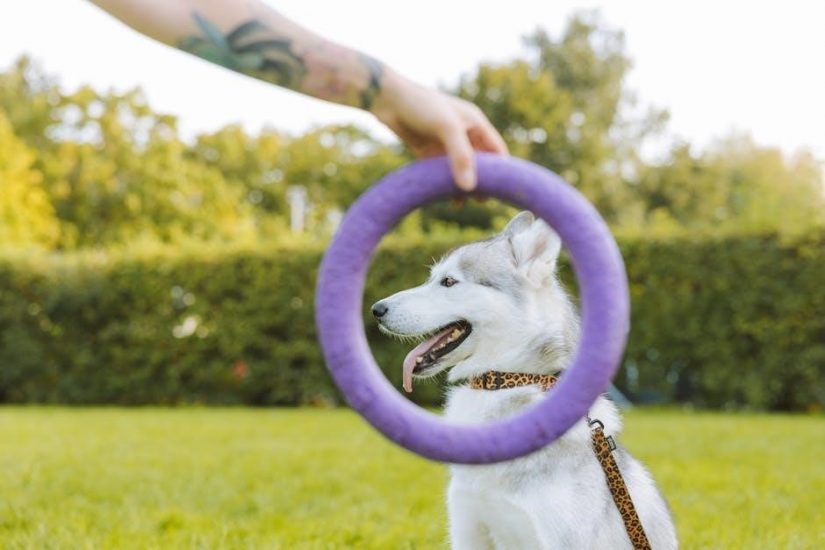Hand signals are a powerful tool in dog training, offering clear communication and consistency․ They help dogs understand commands visually, especially in noisy environments or for hearing-impaired dogs․
1․1 Why Hand Signals Are Important in Dog Training
Hand signals are essential in dog training as they provide a clear, visual language for dogs to understand commands․ Unlike verbal cues, hand signals are universal and consistent, reducing confusion․ They are particularly beneficial for deaf or hard-of-hearing dogs, ensuring effective communication․ Consistency in hand signals helps dogs learn faster and perform tasks reliably․ A dog training hand signals chart PDF offers a standardized reference, making it easier for owners and trainers to use the same signals․ This visual guide enhances training sessions, ensuring clarity and helping dogs focus on the intended behavior rather than verbal instructions․
1․2 Brief Overview of Hand Signals and Their Benefits
Hand signals are visual cues that enhance dog training by providing clear, consistent communication․ They help dogs understand commands without relying solely on verbal instructions, reducing confusion․ Benefits include improved focus, as dogs can concentrate on the signals rather than distractions․ A dog training hand signals chart PDF serves as a handy reference, ensuring consistency across training sessions․ These signals are versatile, aiding in basic obedience, agility, and even advanced tasks for service dogs․ By combining hand signals with positive reinforcement, trainers can create a fun, structured learning environment, making the training process more effective and enjoyable for both dog and trainer․
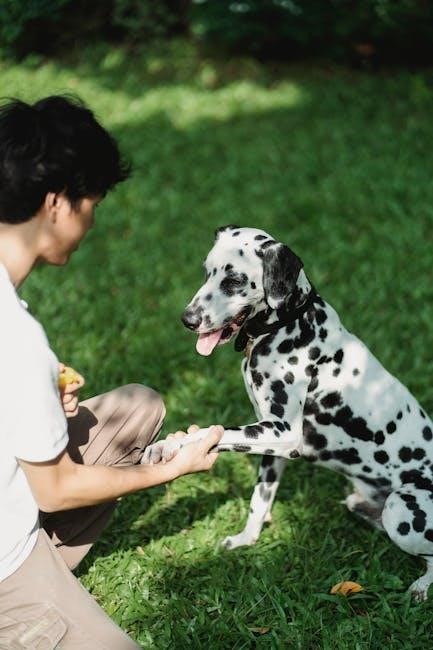
Benefits of Using Hand Signals in Dog Training
Hand signals enhance communication, ensure consistency, and provide universal understanding for dogs․ They reduce confusion and distractions, making training more effective and enjoyable for both dog and trainer․
2․1 Clear Communication Between Dog and Trainer
Hand signals provide a clear and direct way to communicate with your dog, ensuring they understand commands without confusion․ Visual cues are especially helpful in noisy environments or when verbal commands are less effective․ By using consistent hand signals, you establish a reliable method of communication, which is essential for effective training․ Dogs respond well to visual cues, as they often rely more on body language than verbal instructions․ This clarity helps build trust and strengthens the bond between you and your dog, making training sessions more productive and enjoyable for both parties․ Consistency is key to fostering clear communication and successful learning․
2․2 Consistency in Training Sessions
Consistency is vital in dog training, and hand signals play a significant role in maintaining uniformity․ By using the same hand signals each time, you avoid confusing your dog, allowing them to learn commands more efficiently․ A printable dog training hand signals chart PDF ensures that all handlers, including family members or trainers, use the same signals, reinforcing consistency․ This uniformity helps your dog recognize and respond to commands reliably, regardless of who is giving them․ Over time, consistent hand signals build trust and make training sessions more predictable and effective, leading to faster learning and a stronger bond with your dog․
2․3 Universal Understanding for Dogs
Hand signals provide a universal language that dogs can easily understand, transcending verbal commands․ Dogs are visual learners, and consistent hand signals help them grasp commands quicker․ A printable chart ensures everyone uses the same signals, avoiding confusion․ This universal approach is especially beneficial for dogs in multi-handler environments or service situations․ Hand signals also aid in noisy settings where verbal commands might be missed․ By standardizing these signals, you create a clear, reliable communication system that fosters trust and accelerates learning․ This universal understanding strengthens the bond between you and your dog, making training more effective and enjoyable for both parties involved in the process․

Basic Hand Signals Overview
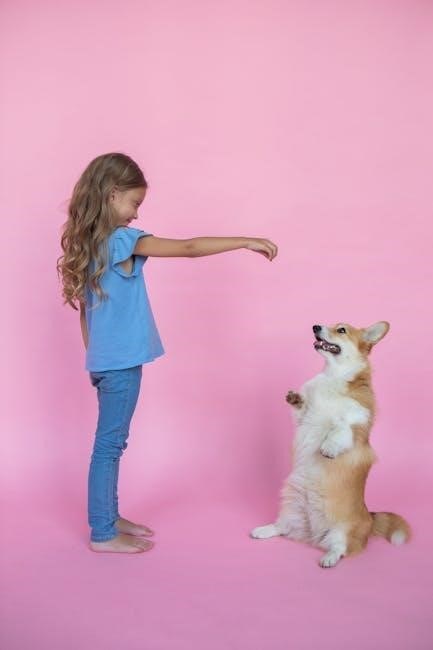
Hand signals provide clear, consistent visual cues, making them easy for dogs to understand․ A printable chart helps maintain uniformity in training sessions․
3․1 Common Hand Signals for Basic Commands
Common hand signals for basic commands include clear, consistent gestures that dogs can easily recognize․ For “Sit,” hold an open palm facing upward and move it upward․ For “Stay,” extend a flat hand like a stop sign․ “Come” involves extending an arm with a beckoning motion․ “Down” starts with a palm facing down, then moves downward․ These signals are simple, distinct, and effective for communication․ Using a printable chart ensures consistency and helps dogs learn faster․ Clear visual cues reduce confusion, making training sessions more productive․ Consistency in hand signals strengthens the bond and understanding between dog and trainer, enhancing overall training success․
3․2 How to Use Hand Signals Effectively
Using hand signals effectively requires consistency and clarity․ Start by ensuring your gestures are distinct and easy for your dog to recognize․ Always use the same signal for a specific command to avoid confusion․ Begin with basic commands like “Sit” or “Stay,” gradually introducing more complex signals․ Pair each signal with a verbal command and positive reinforcement, such as treats or praise, to reinforce learning․ Be patient and repeat the process until your dog responds reliably․ Over time, your dog will associate the signals with desired behaviors, making communication smoother and training more efficient․ Consistency is key to mastering hand signal training․
3․3 Tips for Teaching Hand Signals
Start with basic commands and gradually introduce more complex signals․ Use a consistent hand gesture for each command to avoid confusion․ Begin with your dog in a calm state and use positive reinforcement, such as treats or praise, to encourage learning․ Practice in different locations to help your dog generalize the signals․ Be patient and repeat the process until your dog responds reliably․ Use a marker signal, like “yes,” to indicate correct behavior․ Keep sessions short and fun to maintain your dog’s focus․ Over time, phase out rewards as your dog becomes more proficient․ Consistency and patience are key to successful hand signal training․
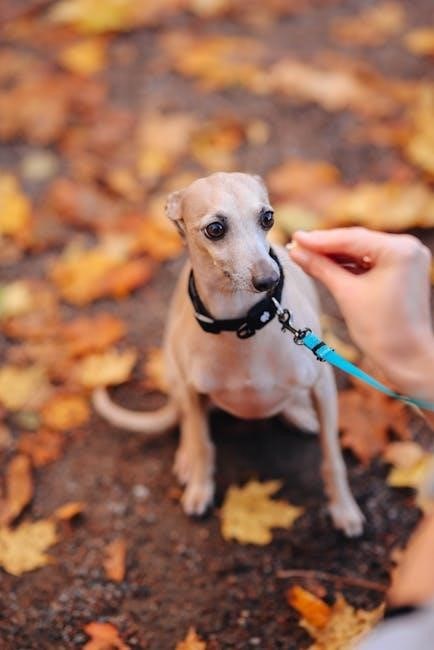
Training Your Dog with Hand Signals
Training your dog with hand signals enhances communication and consistency․ Start with basic commands like “sit” and “stay,” using clear gestures․ Pair signals with verbal commands initially, then phase out words․ Use positive reinforcement with treats or praise to encourage learning․ Keep sessions short and fun to maintain engagement․ Practice in various locations to help your dog generalize signals․ Be patient and consistent, breaking commands into smaller steps if needed․ Over time, your dog will learn to respond reliably to hand signals, improving your bond and their understanding․
4;1 Pairing Commands with Hand Signals
Pairing commands with hand signals is essential for clear communication․ Begin by using a verbal command your dog already knows, then introduce the corresponding hand signal․ For example, say “sit” and make the sit gesture․ Consistently link the command and signal to help your dog associate them․ Use positive reinforcement, like treats or praise, when your dog responds correctly․ Over time, phase out the verbal command, relying solely on the hand signal․ This method ensures your dog learns to recognize and respond to visual cues effectively․ Be patient and consistent, as this pairing process lays the foundation for successful hand signal training․
4․2 Using Lures and Rewards
Using lures and rewards is a highly effective way to teach hand signals․ Begin by holding a treat or toy near your dog’s nose and moving it in the direction of the desired action, such as upward for “sit” or downward for “down․” As your dog follows the lure with their head, they naturally perform the behavior․ Immediately reward them with the treat and praise․ Over time, phase out the lure, using only the hand signal and occasional rewards to maintain their focus․ This method helps your dog associate the hand signal with the action and reinforces good behavior through positive reinforcement․
4․3 Keeping Training Sessions Fun and Positive
Keeping training sessions fun and positive is crucial for your dog’s engagement and learning․ Use upbeat energy, playful tones, and plenty of praise to create an enjoyable environment․ Incorporate your dog’s favorite toys or treats as rewards to maintain their interest․ Short, frequent sessions prevent boredom and stress, while ending on a positive note leaves your dog eager for the next session․ Mixing hand signals with familiar commands adds variety, making learning exciting․ A positive atmosphere fosters trust and accelerates the learning process, ensuring your dog remains motivated and enthusiastic about training with hand signals․
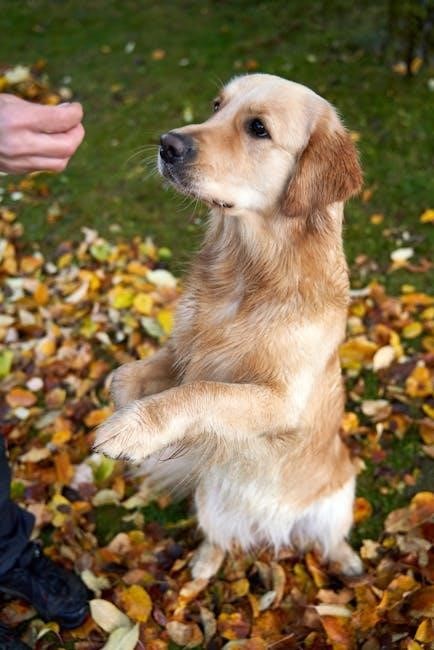
Common Dog Training Hand Signals
Common hand signals provide clear, visual cues for dogs, enhancing communication and consistency․ They are essential for effective training․
5․1 Sit Command Hand Signal
The sit command hand signal involves holding your palm facing upwards and moving your hand upward from your thigh toward the sky․ This clear gesture helps your dog associate the visual cue with the action of sitting․ Start by having your dog on a leash or in a controlled environment․ As they learn, gradually phase out treats and verbal commands․ Consistency is key—ensure everyone uses the same signal․ If your dog doesn’t respond immediately, calmly guide them into position and reward when they sit․ Over time, this signal becomes a reliable way to communicate the sit command, fostering clear communication and obedience․
5․2 Stay Command Hand Signal
The stay command hand signal is performed by holding your hand flat with your palm facing outward, similar to a stop sign․ Stand facing your dog and extend your arm at shoulder height․ This signal indicates that your dog should remain in place․ Start with short durations and gradually increase the time as your dog becomes more reliable․ Consistency is crucial—use the same gesture every time to avoid confusion․ Reward your dog when they successfully stay, reinforcing the behavior․ If your dog breaks the stay, calmly guide them back to the correct position without punishment․ Over time, this signal will help your dog understand the stay command clearly and respond consistently, even in distracting environments․
5․3 Come Command Hand Signal
The come command hand signal involves extending your arm straight out in front of you, palm facing upwards, and sweeping it toward your chest․ This gesture signals your dog to leave their current position and return to you immediately․ Start by using the signal alongside verbal cues and rewards to help your dog associate the movement with the command․ Gradually increase the distance and distractions to reinforce reliability․ Consistency is key—always use the same motion to avoid confusion․ If your dog hesitates, avoid chasing them; instead, encourage them with positive reinforcement when they respond correctly․ Over time, this signal will become a clear and reliable way to summon your dog, even in challenging situations․
5․4 Down Command Hand Signal
The down command hand signal involves holding your hand, palm facing upwards, and moving it downward toward the ground․ This motion guides your dog to lower themselves from a sit or stand into a lying position․ To teach this, start by holding a treat near your dog’s chest and slowly moving it down toward the ground․ As they follow the treat with their nose, they will naturally lie down․ Once your dog is in the correct position, give the treat and praise․ Consistency in using this signal is crucial to ensure your dog understands the gesture․ Over time, your dog will learn to respond to the hand signal alone without the lure․

Advanced Hand Signals for Specific Needs
Advanced hand signals cater to specialized training, such as service dogs or agility, requiring precise, dynamic gestures tailored to specific tasks and environments for optimal performance․
6․1 Hand Signals for Service Dogs
Service dogs require tailored hand signals for specific tasks, ensuring clear communication in public settings․ These signals must be consistent, precise, and easily distinguishable to assist individuals effectively․
6․2 Hand Signals for Agility Training
Hand signals play a crucial role in agility training, where dogs navigate obstacle courses․ Clear signals help dogs understand directions quickly․ Common signals include “come,” “jump,” and “weave,” each with specific gestures․ Consistency is key to avoid confusion․ Use open palms and exaggerated movements for clarity․ Start with basic commands, gradually introducing more complex signals․ Positive reinforcement, like treats or praise, encourages quick learning․ Keep sessions fun and engaging to maintain focus․ Over time, dogs learn to respond effortlessly, making agility training an enjoyable bonding experience․ Ensure signals are universal for consistency, especially in competitions or group settings․
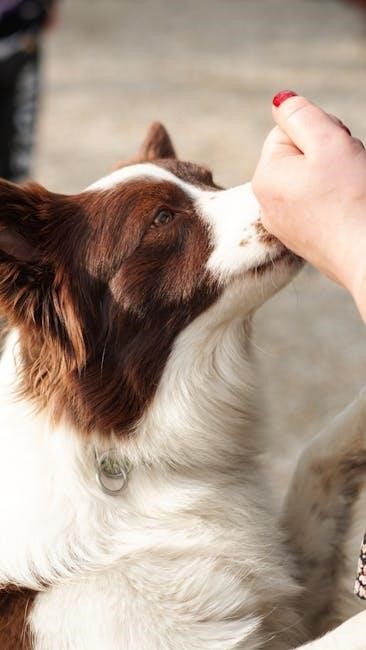
Creating a Dog Training Hand Signals Chart PDF
A printable hand signals chart provides a clear, consistent visual guide for training․ It helps standardize commands, making learning easier for dogs and trainers alike․
7․1 Why a Printable Chart is Helpful
A printable hand signals chart offers clarity and consistency in training․ It serves as a visual reference, ensuring that commands are performed uniformly․ This consistency reduces confusion for dogs, as they can associate each signal with a specific action․ Having a physical chart allows trainers to refer to it during sessions, maintaining focus and structure․ Additionally, it can be shared with others, such as pet sitters or veterinarians, to maintain training continuity․ The chart also serves as a helpful tool for tracking progress and reinforcing learned behaviors․ Its simplicity and accessibility make it an invaluable resource for effective dog training․
7․2 Designing Your Own Hand Signals Chart
Creating a custom hand signals chart tailored to your dog’s needs enhances training efficiency․ Start by listing essential commands like “sit,” “stay,” and “come․” Assign distinct hand gestures for each, ensuring clarity and consistency․ Use visuals or sketches to depict each signal clearly․ Organize the chart in a logical sequence, grouping related commands together․ Include space for notes to track progress or modifications․ A clean, visually appealing design aids in quick reference during sessions․ Printing it on durable material ensures longevity․ Personalizing the chart allows you to focus on your dog’s specific training goals, making it a practical and effective training aid․

Troubleshooting Common Issues
Addressing challenges like ignored signals or confused cues is crucial․ Simplify commands, ensure consistency, and use positive reinforcement to resolve issues and improve understanding․
8․1 When Your Dog Ignores Hand Signals
If your dog ignores hand signals, ensure consistency in your cues․ Simplify commands, break them into smaller steps, and use positive reinforcement․ Avoid distractions initially and reward focus․ Be patient, as clear visual cues can help your dog understand better․ Consistency and positive reinforcement are key to resolving this issue effectively․
8․2 Simplifying Commands for Better Understanding
Simplifying commands can significantly improve your dog’s comprehension․ Break complex actions into smaller, manageable steps and use consistent hand signals․ For example, when teaching “sit,” use a clear palm-up gesture and reward immediately․ Avoid mixing signals or adding unnecessary movements, as this can confuse your dog․ Positive reinforcement, such as treats or praise, reinforces the connection between the signal and the action․ Keep training sessions short and fun to maintain focus․ By simplifying commands, you create a clearer path for your dog to learn and respond effectively, addressing common issues like ignored signals or miscommunication․
Hand signals simplify dog training, enhancing communication and consistency․ They strengthen the bond between dog and trainer, making learning easier and more enjoyable for both․
9․1 Summary of Key Points
Hand signals enhance dog training by providing clear, consistent communication․ They reduce confusion and distractions, making learning easier for dogs․ Using a printable chart ensures uniformity in training, benefiting both trainers and dogs․ Positive reinforcement, patience, and repetition are essential for successful hand signal training․ Dogs, especially deaf or hearing-impaired ones, greatly benefit from visual cues․ Consistency in signals strengthens the dog-trainer bond, making commands more effective․ A well-designed chart serves as a helpful reference, ensuring everyone involved in training uses the same signals․ This standardized approach fosters better understanding and faster learning, creating a more enjoyable and productive training experience for all․
9․2 Final Tips for Successful Hand Signal Training
Keep hand signals simple and consistent to avoid confusing your dog․ Always pair signals with verbal commands initially, then phase out words as understanding grows․ Use positive reinforcement like treats or praise to encourage correct responses․ Start with basic commands and gradually introduce more complex ones․ Practice regularly in various environments to improve reliability․ Be patient, as dogs learn at their own pace․ Celebrate small successes to keep sessions positive․ Use a printable chart as a visual guide for consistency․ Incorporate fun elements, like treats or toys, to make training enjoyable․ Over time, your dog will rely on hand signals alone, strengthening your communication bond․
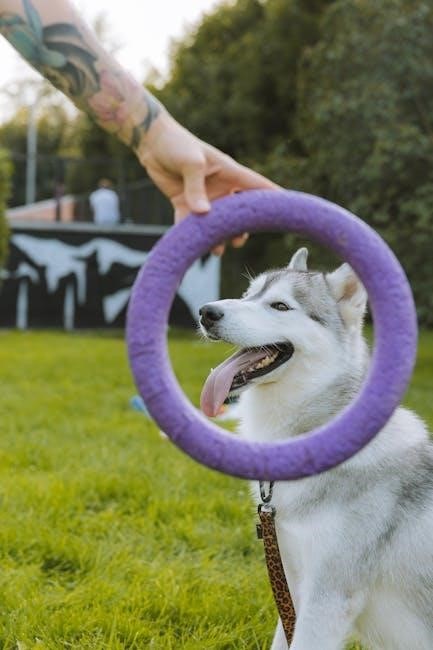
Additional Resources
Explore recommended links, forums, and guides for detailed hand signal training․ Downloadable charts and expert tips are available to enhance your training journey with your dog․
10․1 Recommended Links for Dog Training
For comprehensive guides and detailed charts, visit DogTraining and ASPCA․ These sites offer printable hand signal charts and expert tips․ Check out forums like DogTrainingForum for community support and shared resources․ Download the Basic Dog Commands Chart for a visual guide to common signals; Explore ServiceDogTraining for specialized tasks and PuppyTraining101 for age-specific advice․ These links provide valuable tools and insights to enhance your hand signal training journey with your dog․
10․2 Further Reading on Hand Signal Training
Explore in-depth guides like “Advanced Hand Signals for Canine Communication” and “Visual Cue Training for Service Dogs”․ These resources provide detailed methods for teaching hand signals, including step-by-step tutorials and real-life examples․ For a deeper understanding, check out “The Science Behind Hand Signal Training”, which explains how dogs process visual cues․ Additionally, “Training Your Dog with Hand Signals: A Comprehensive Guide” offers practical advice for consistency and effectiveness․ These materials are perfect for trainers seeking to refine their techniques and improve communication with their dogs․
